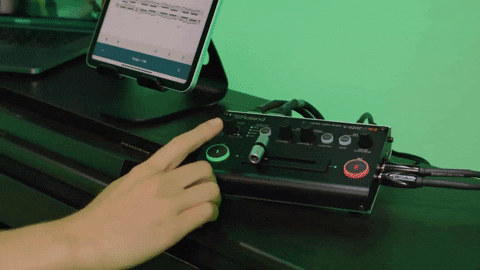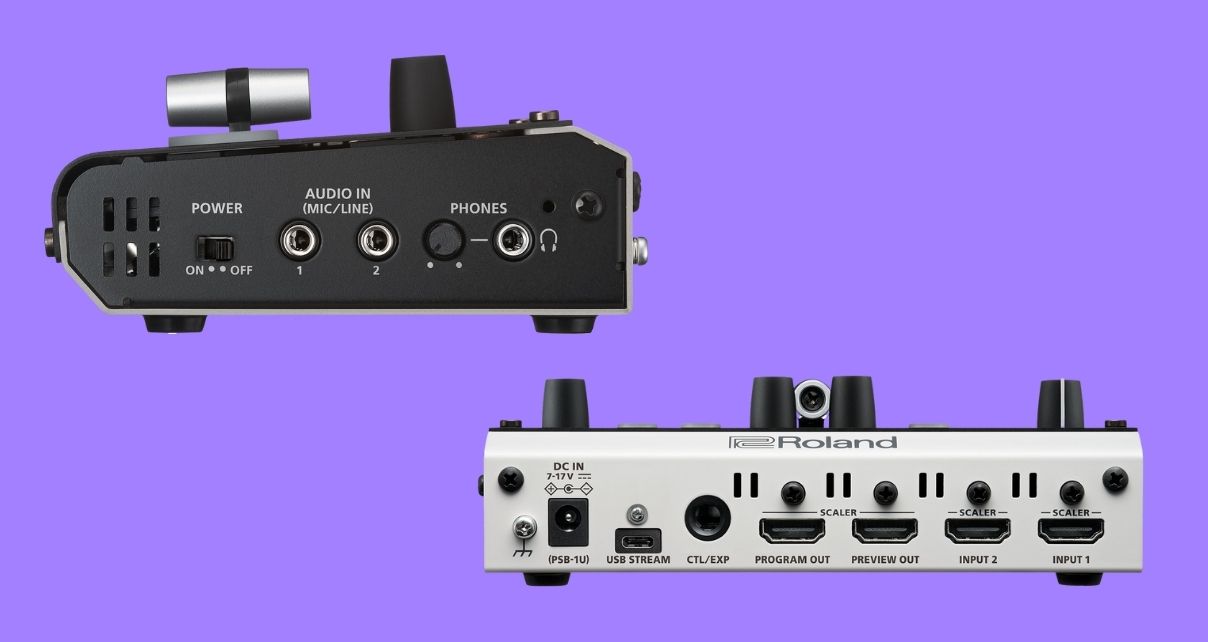0 Comments
The Lowdown
The Roland V-02HD MkII is the replacement for the company’s popular V-02HD video mixer, aimed firmly at all types of livestreamers, and would be a great choice for DJs wanting to use HDMI-output cameras to level up their DJ livestreams – assuming you know you’ll never want to use more than two cameras. It’s small, well made and easy to learn.
Video Review
First Impressions / Setting up
The Roland V-02HD MkII is the replacement for the company’s popular V-02HD video mixer, aimed firmly at livestreamers, and I’m guessing especially at gaming streamers, who want to mix computer outputs with their headshots, and maybe use green screen and cool video effects too.
However, it would also be totally suitable for DJs wanting to stream their DJ sets using high quality HDMI cameras and feeding in both microphone audio and music, and this is the use case we’ll concentrate on in this review.
Read this next: Which Camera Is Best For DJ Set Livestreaming?
So – say you’re a DJ wanting to up your livestreaming game from maybe webcams or phone cameras, and instead you figure you’d like to use use higher quality HDMI video sources such as those from DSLR cameras. You’d actually soon realise you have a couple of choices.
You could use individual capture cards (such as the Elgato Cam Link interface) to get video into your computer, and then combine those video sources in software such as OBS along with audio to then stream out to the internet. This way, all the clever stuff happens in your computer.
Alternatively, you could go for a hardware solution – of which the little Roland V-02HD MkII is one example. So why choose hardware? One advantage of a hardware solution is that it is a piece of equipment on your desk that you manipulate rather than having to control everything via a laptop. This differentiation is particularly important if the laptop you’re livestreaming with/from is the same one you run your DJ software on.
Another advantage is that it potentially offers higher quality and smoother operation, because the hardware is doing the “heavy lifting” for you rather than your computer.

To be clear, you’d still need to feed the output from the video mixer into your computer (some people even use a second computer if they are using one for DJing with) to get your show live on the internet using switcher software such as OBS, but the system will be easier to use and have far less to do.
And so to the Roland V-02HD Mk II itself – possibly the smallest such device out there. Upon unboxing it is clear that this is a well made device. It’s small, solid and weighty, with metal construction and with a black and white painted finish. On top it has a few knobs and buttons across the top half, and a video1/video 2 T-bar (think: crossfader) and two big video buttons backlit red/yellow/green to the left and right of that.
Round the back are the DC power input (a power brick is provided, of course) and cable grip screw, two full-sized HDMI inputs, two HDMI outputs (for separate “preview” and “live” monitors, if you wish to have both), and a 1/4″ jack socket for a foot pedal allowing you to switch cameras without using your hands – a great option for DJs.
To set up, you plug in HDMI cables from your cameras (most cameras with clean HDMI outputs use mini HDMI, so you’ll need to be sure you have the right leads), plug in USB C 3.0 from the V-02HD MkII into your computer, and plug in at least one monitor via HDMI.

(I have no need for a separate preview and live monitor, which I suspect will be the same for most users in a two-input set-up, so I plugged into the Preview output, which you can then configure to show you the master, ie what your audience is seeing. The advantage here is that it also lets you see the unit’s config menu items, which don’t show on the Master. More on this later.)
There are two 1/8″ minijack sockets for audio alongside an 1/8″ minijack socket for headphones on the right-hand side, and you can potentially plug in both your decks and a microphone here; this is also where you find the small on/off switch.
Once this is all connected, you’re ready to send a high-quality two camera/feed plus audio source signal direct to your computer from the unit via USB-C 3.0, which is then seen by your computer as a standard webcam input. That means you can select it as your source on your computer, and that way, not only go live on Twitch, YouTube and so on using software like OBS, but also potentially feed the whole lot into Zoom, Skype – whatever you like. You could also, of course, use it to simply record a DJ set.
In Use
I used the mixer in our livestream set-up in the Digital DJ Tips studio, to swap between the overhead and the main cameras. It fed via USB-C into Ecamm Live, our video production software, to go live to Twitch and YouTube. I used music through the built-in audio input, but my mic fed in directly to the computer, as I use a USB mic.
Out of the box, it worked fine without needing to adjust anything. The T-bar/crossfader for blending between images looks and feels really professional, and you can tap a button to switch from simple fade to a “wipe”. Tapping it again lets you put a “picture in picture” view up, and pressing it again lets you use either a green screen or fade text/an image in/out of the foreground, for titling for instance – this all depends on what you have as your second input.

Now, adjusting some of these additional features from the hardware requires you to access the menus, and to do that, you need a monitor connected – if you’re only going to use one monitor, you’ll connect it to the Preview Out. You’ll then set that to show you the Master output so you can see what your audience is seeing, but this setting also lets you use the same monitor for menu navigating (as the Preview Out is the only one that shows you the monitor inset).
Tapping the Menu buttons brings up the menu, where you can change all kinds of things: You can assign video input sources, set transition time, set the type of wipe you want, adjust the size and position of your picture-in-picture, and set up both key and chroma, including setting the other camera or a still image as your source.
Livestream your DJ sets like a pro: DJ Livestreaming Made Easy
There are heaps of visual effects built in too. There’s “mosaic”, and you get to set this to either part of the screen (again, you can define which part in the settings), the whole screen, or the background. Another I liked was Colorpass (which preserves one colour when turning the rest of the video black and white), but there’s also negative, hue and saturation adjustments, monochrome, and several more. Often, the Control 1 and Control 2 knobs allow you to change things about the effects eg mosaic, and these knobs also control horizontal/vertical for the Picture in Picture.
There are lots of audio adjustments for the two inputs as well, including gain and level controls, control over camera audio and so on, so you’ll easily be able to dial in your preferred audio settings alongside video.
In practice, you’ll figure out your way of working with the V-02HD Mk II, and it’ll all be intuitive, reliable and simple to use – just how such things should be when you’re busy DJing.
Conclusion
In many ways, this unit is notable for what it isn’t. It isn’t a big, complicated solution that needs lots of learning, It’s a simple two-input video mixer with just enough features provided for a high quality, two-camera set-up. This, it turns out, is exactly the type of two-camera set-up a DJ might want, with an overhead camera, and a “front cam”.
The audio input features are just about enough, although most DJs will probably use the Mic In socket on their DJ gear, and only feed in the one audio input. But if you want to feed in tow, rudimentary routing, muting and mixer controls are all there for you in the menu.

The green screen capability might just prove to be the killer feature. Using this, you could, for instance, have just a one-camera set-up (a camera showing both you and your decks), but be feeding a computer output or still image from another source into the second input, and use that as a green screen background – meaning you could play your livestreams from “anywhere”.
Read this next: The Ultimate Guide To DJ Livestreaming
Worth pointing out that this is HD only (not 4K), although for livestreaming that is not an issue, as no livestreaming platform allows 4K at this time. Also, unlike some hardware video mixers, this can’t go live straight to the internet via Ethernet – you still need to use the USB-C output (or the HDMI output, via an interface) to get the output into an computer and encoder software to do that.
One thing that did occur to me was that it would be nice to have a single HDMI monitor out, with a multi-view option, so you could plug in just a single monitor and see both of your cameras/inputs AND the “master” all on one screen if you wanted – for a device as simple as this, I do wonder how many people would ever plug two monitor screens in.
Bottom line: This is the very basic starting point for anyone wanting high-quality HDMI video mixing and interfacing with a computer, and what it does, it does really well. You don’t even need to add a small video monitor screen, as you can always use your laptop as a “monitor” if previewing isn’t important to you.
If this is all you think you’ll ever need, it’s a highly professional solution.




